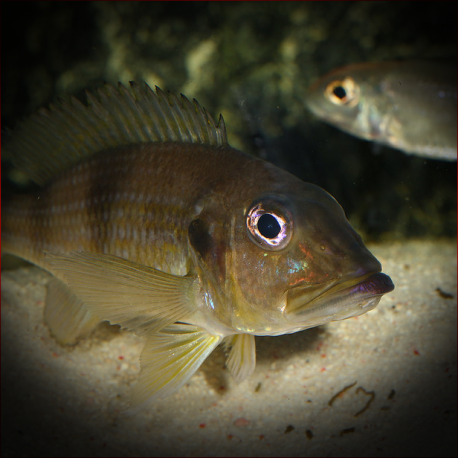More info
Datasheet
| Minimum Tank Size | 110 litres / 29.06 US gallons |
| Maximum Size | 15.0cm / 5.91inches |
| Temperature | 22°C / 71.60°F - 27°C / 80.60°F |
| Hardness | 8-25ºdH |
| pH | 7.5-9.0 |
General Description:The Gnathochromis Permaxillaris, previously classified in the genus Limnochromis, showcases unique behavior with enlarged upper lips for sand-sifting activities and preference for deep waters up to 200 meters in Lake Tanganyika. This cichlid, reaching up to 15.0cm, is a rare find due to its sensitivity to water quality and limited shoal presence, making it unsuitable for novice aquarists.
Aquarium Setup:For optimal housing, a tank of at least 110 litres is required, with a setup including large rock formations forming caves, open water areas, and a sandy substrate under dim lighting conditions (see table for specific water parameters). The dimly lit environment mimics its natural habitat to reduce stress levels.
Behaviour:Gnathochromis Permaxillaris is not aggressive and suits peaceful tankmates like Cyprichromis and Tanganyikan Synodontis. They thrive in groups and should not be housed with boisterous species like Mbuna. The species demonstrates a calm demeanor, making it an ideal addition to community tanks of suitable size.
Feeding and Diet:Live and frozen foods should form a significant portion of the diet, with occasional dried food offerings. The fish sifts sand for hidden invertebrates, resembling Geophagus species. Feeding habits mirror natural foraging behaviors, enhancing their overall health in captivity.
Reproduction & Dimorphism:Breeding Gnathochromis Permaxillaris in aquariums is infrequent, with limited information available. They engage in bi-parental cave-spawning and mouthbrooding, with both parents caring for the fry. Sexual dimorphism is challenging to discern, requiring careful observation for distinguishing traits.
Habitat and Distribution:Endemic to Lake Tanganyika, Gnathochromis Permaxillaris is seldom encountered due to its preference for deeper waters and solitary or small shoal presence. Their habitat spans the lake but remains elusive to most observers, necessitating careful monitoring for research purposes.

